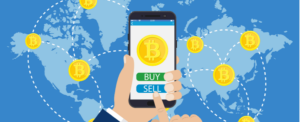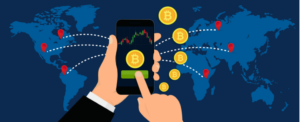Just a few years ago, a bunch of software developers started experimenting with digital collectibles on Ethereum. They proposed a new token standard, known as ERC-721, which would allow anyone to build non-fungible tokens on the network. Unlike ordinary tokens, each NFT created would be unique, opening the door for a world of digital collectibles to emerge. Today, everyone from rapper The Weeknd, popular Youtuber Logan Paul and the New York Times have gotten in on the craze.
But what exactly is an NFT, and what does it mean to own one? In this article, we’ll break through the hype to reveal all you need to know about the groundbreaking NFT space and how to go about buying your first non-fungible token on an NFT marketplace. After we secure our first piece of NFT art, we’ll take a look at some of the challenges facing NFTs today.
What is the meaning of NFT?
As we mentioned in the introduction, NFT stands for non-fungible tokens. To understand what an NFT is, we must first understand the concept of fungibility and fungible tokens.
Fungibility is a characteristic of assets. A fungible token is an asset where one unit can be interchanged for another unit. For example, the US dollar is fungible. If Todd gives Noa a 10 dollar bill, and Noa transfers $10 back to Todd’s bank account, they both leave the exchange even. In the crypto sphere, currencies and utility tokens like Bitcoin, Ethereum and Cardano are all fungible tokens.
A non-fungible token, on the other hand, cannot be interchanged. It is unique. When it comes to tokens, NFTs are certificates testifying to the authenticity and uniqueness of digital items. A song, a piece of art, and even in-game items can be represented as NFTs.
Non-Fungible Tokens: There’s More to It Than NFT Art
It makes sense that art is currently leading the way as far as NFT use-cases are concerned. For centuries, art has served as an object of pleasure, a financial investment, and a status symbol. NFT art leverages the transparency and immutability of blockchain when it comes to proving authenticity and ownership. It effectively creates a ‘digital watermark’ that creators can append to their art, logos, images, and multimedia files. Anything creative you can make can also be represented by an NFT and exchanged on open markets. Fun fact: The most expensive NFT ever was sold by Christie’s for $69 million!
Beyond art, NFTs are powering a new wave of interest in collectibles. Human beings enjoy accumulating collectibles starting from childhood as it gives us a sense of ownership and control. We collect stamps, antiques, baseball cards, vintage sneakers, and anything else of value that we can get our hands on. And we’ve taken our lust for collections to the digital sphere first, as evidenced by the popularity of collectible platforms such as Cryptokitties and NBA Top Shot.
One area of NFTs that has received less attention is their use in gaming. For example, NFTs could represent in-game items such as weapons, unique characters, clothing items, and more. Gaming is a thriving $167 billion industry, and NTFs have the potential to transform how in-game items are bought and sold, creating new revenue streams for gaming labels and gamers alike.
How To Buy Your First Non-Fungible Token from an NFT Marketplace
Without further ado, it’s time to get our hands on some NFT art. To follow along with the tutorial, you’ll need to have Metamask installed and loaded with some Ether. Don’t worry if you don’t have a loaded Metamask wallet already, we’ll be covering these steps together. Feel free to skip straight to the final step if you’ve already got your Metamask ready.
If you don’t have any Ether, now is the time to get some! Head over to Coinmama and buy some Ether with one of our many payment methods available.
Step 1: Install Metamask
Metamask is more than just a wallet. It is the gateway to the decentralized web and the world of crypto. It’s available for download as both a browser extension and a mobile app and supports many different networks and apps. Head over to the Metamask website and download the version that suits your needs. And don’t forget to backup and secure your wallet! Make sure to write down your seed and store it in a safe place.

Step 2: Get some ETH on Coinmama
Now’s the time to arm yourself with some Ether with which to buy those NFTs. Head over to our Ethereum page to purchase your Ether with one of our many different payment options. At the checkout, make sure to enter the address of your Metamask wallet to receive your coins.

Step 3: Head over to the NFT Marketplace and buy your NFT!
NFTs are bought and sold on NFT marketplaces. Many such marketplaces exist, and more are popping up all the time. We’ll be buying off OpenSea, one of the longest-running and most popular NFT marketplaces. When logging into OpenSea, it will ask you to connect your MetaMask. Go ahead and connect it. Clicking on the ‘Browse’ tab in the main menu will take you to the marketplace, where you can view and buy NFTs.

You’ll notice a few options such as ‘Buy Now’ and ‘On Auction’ located on the main menu bar/ That is because OpenSea allows creators to sell NFTs either directly or through an auction. OpenSea and other marketplaces also employ a similar ‘blue checkmark’ system that Twitter and Instagram use to verify the identity of high-profile individuals.
The NFT we’ll be buying is a ‘Buy Now’ kind of NFT. Being an avid sports fan, I decided to buy an NFT commemorating Mario Gotze’s memorable winning goal that handed Germany the 2014 World Cup win over Argentina. All I had to do was click Buy Now and confirm the prompts on MetaMask, and viola, I’m now the proud new owner of an animated sports moment.

What are some of the challenges currently facing NFTs?
A good rule of thumb in crypto is to treat any hot new fad with a healthy dose of skepticism. We saw how the hype surrounding Initial Coin Offerings (ICOs) back in 2017 quickly gave way to disappointment and disbelief when the market subsequently came crashing down. While the excitement surrounding NFTs is understandable, the space as a whole still faces a few crucial challenges to its sustainability.
The ‘Screenshot Problem’ – One of the things that makes art so valuable is its exclusivity. When you pay for a piece of art, you take it back to display in your house or office, and only you and those invited by you get to enjoy it. Not so with an NFT. Many NFTs are available for viewing on the marketplace even after they are sold. While some creations allow owners to view locked content, you can enjoy the viewing experience of most NFTs and even screenshot them to preserve them on your devices. At the same time, NFTs hold additional value since nobody will buy my screenshot, but they may buy my NFT.
The ‘Centralized Storage Problem’ – NFT collectors can be lulled into a false sense of security when hearing that their NFTs are built on Ethereum. With over 4,700 Ethereum nodes and counting, the risk of losing any data that is stored on the Ethereum blockchain is tiny. That being said, NFTs aren’t stored on Ethereum proper. This common misconception arises because the blockchain does, in fact, store some of the metadata related to NFTs, such as the owner’s address and the NFT’s unique ID. However, the actual media file isn’t stored on the blockchain itself. That’s because storing rich media files would bloat the size of the blockchain, making it impossible to run for all but the most well-capitalized data centers and harming decentralization in the process.
So, where is the file stored? In some cases, NFT creators store their media files on IPFS, a distributed file storage system that enjoys many of the same properties as Ethereum. However, many NFT media files are stored on private servers. In such a case, if the company hosting the server shuts down, then the file is lost forever.
Both problems are solvable, and more solutions are coming online with each passing day. Yet, it’s essential to bear these in mind before spending too much time and money collecting NFTs.
Finally, don’t forget that you have to pay gas fees in Ether for all Ethereum blockchain transactions. This includes buying, selling, listing, and transferring NFTs.
An Ever-Expanding NFT Marketplace
Beyond the current crop of collectibles and art lies an emerging space that combines cutting-edge technologies such as virtual and augmented reality together with NFTs. Known as the ‘metaverse,’ this space brings games, social media and other virtual worlds together in a single, interconnected experience. Just as we can own real-estate in the physical world, so too NFTs enable us to own digital property in the ever-expanding metaverse. It might sound like a sci-fi dream, but owning digital real-estate in the metaverse is becoming more real by the day and turning the world into a massive NFT marketplace.
So you’re MetaMask is now all fired up, you’ve loaded it with Ether and you have all the information you need to buy and sell some shiny new NFTs. You’re well on your way to becoming a true crypto collector.


